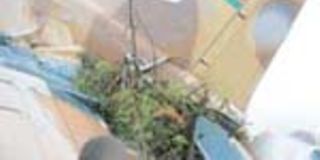Marsabit: Pilot error most likely

The plane that crashed in Marsabit.
Military and aviation experts investigating the Marsabit plane crash, which killed 14 people two weeks ago, are pursuing pilot error as the most likely cause.

The plane that crashed in Marsabit.Photo by File
Part of the investigation by the team picked by Chief of General Staff Jeremiah Kianga has focused on the social circumstances, state of health and events surrounding both pilots hours before the April 10 crash of the Y-12 military aircraft.
While initial reports confirmed the weather over the Marsabit airstrip was bad that morning, sources privy to military and civil aviation flight regulations told the Sunday Nation that pilots must avoid landing in certain aerodromes if the runway is not visible from 200 feet above ground.
Soon after the crash, forensic experts took blood samples from the bodies of the pilots to be examined by the Government Chemist in Nairobi. The results remain unknown.
Other sources said information gathered so far had not given credence to speculation of a mechanical problem with the Kenya Air Force transport Harbin Y-12, one of six aircraft imported from China five years ago.
A Government statement released soon after the crash in which six Kenyan Members of Parliament perished said initial indications pointed to "poor visibility caused by bad weather over Marsabit hill".
A senior aviation official who did not want to be named, as investigations are still going on, said although bad weather was a major flying hazard, domestic and international flight regulations for both military and civilian aircraft were strict and clear on safety measures pilots must observe to avoid accidents.
"We can't deny that the line between bad weather and poor pilot judgement can be thin," one pilot who has flown to Marsabit told Sunday Nation. "Marsabit is one place you have got to give a lot of respect if the weather is bad."
He said among factors that should have deterred the aircraft from landing was the absence of reliable navigational equipment such as the Instrument Landing System, and the nature of the aircraft which was not capable of landing in "zero visibility" in the circumstances around Marsabit on the tragic morning.
The investigation , now its second week, is led by experts from the KAF and the China Harbin Aircraft Manufacturing Corporation, which manufacturers the fixed wing, twin-propeller, multi-purpose aircraft.
Aviation regulations, most of them entrenched in law, outline the Do's and Don'ts governing pilot behaviour. One of them requires pilots to remain alcohol-free in the eight hours preceding their flight. They should also report for duty at least an hour before the flight.
When Gen Kianga picked a team to investigate the crash, Kenya Air Force sources said at the time that the experts would be expected to discover whether the crash was caused by pilot error, bad weather, mechanical faults or anything else.
Speaking to journalists as the crash investigators got to work, military spokesman Bogita Ongeri said the plane was last serviced in February this year and that it had always been maintained according to schedule.
"The plane was sound because it had covered only 1,032 hours out of the 6,000 it was scheduled to," Mr Ongeri said.
And yesterday, an aviator familiar with the events of the Marsabit crash maintained that the accident did not "look like a technical problem with the aircraft".
Other aviation experts suggested that the crash may have been a combination of bad weather and the decisions of the pilot.
A pilot with long experience said that considering the weather over Marsabit that morning, the pilot should not have made an attempt to land. "Pilot error is a most likely pointer," he told Sunday Nation.




